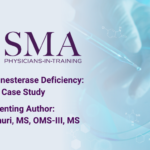Abstract | May 5, 2021
Pseudocholinesterase Deficiency: A Case Study
Learning Objectives
- Upon completion of this lecture, learners should be better prepared to: describe the management of patients with pseudocholinesterase deficiency;
- Upon completion of this lecture, learners should be better prepared to: explain the importance of identifying patients with pseudocholinesterase deficiency.
Introduction
The enzyme pseudocholinesterase metabolizes many drugs commonly used during anesthesia. Most individuals can quickly metabolize these drugs leading to a short duration of action. Individuals with an acquired or inherited deficiency are slow to metabolize anesthetics and may take up to 8 hours to recover from anesthetic administration. About 1 in 3,200 to 1 in 5,000 patients inherit this autosomal recessive trait. It is important to quickly recognize this rare condition as patient care post-surgery will need to include mechanical ventilation until the medication has been fully metabolized.
Case Presentation
Our patient was a 26-year-old female who presented to the emergency department after having a right ovarian cystectomy at a surgery center. After the surgery was completed, the anesthesiologist was unable to extubate the patient safely as the patient was having difficulty recovering from general anesthesia facilitated by succinylcholine. She was under observation for 4 hours without any improvement in her respiratory status. Upon arrival in the emergency department, the patient was able to nod yes and no to certain questions but was unable to lift her legs or head safely. The patient was intubated and ventilated, alert, and awake. Vitals on admission were as follows: BP 123/76 mmHg, pulse 100 bpm.
Final Working Diagnosis
The patient was found to have acute hypoxic respiratory failure secondary to respiratory muscle paralysis requiring mechanical ventilation. This was considered to be secondary to a pseudocholinesterase deficiency. This required the patient to be on mechanical ventilation. She then went through a successful spontaneous breathing trial, was extubated, and stabilized.
Management/Outcome/Follow-up
After four hours of observation without recovery from anesthesia at the surgery center, the patient was transferred to a nearby ICU. Management of pseudocholinesterase deficiency is typically conservative treatment. She was monitored overnight while intubated and sedated. The next morning, she underwent a successful spontaneous breathing trial and was extubated. Prior to extubation, the patient had an O2 saturation of 100% and FiO2 of 30%. A chest CT was performed and showed no evidence of cardiopulmonary disease. The patient was then deemed stable and medically cleared for discharge home with instructions to follow up with primary care in 3-5 days.

